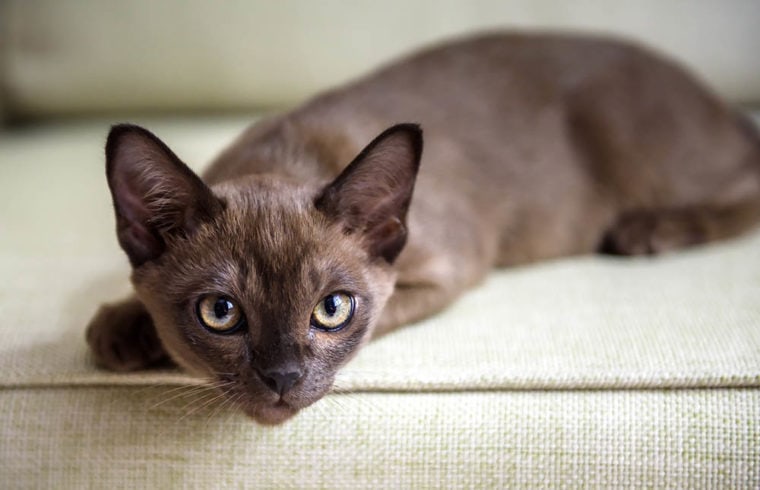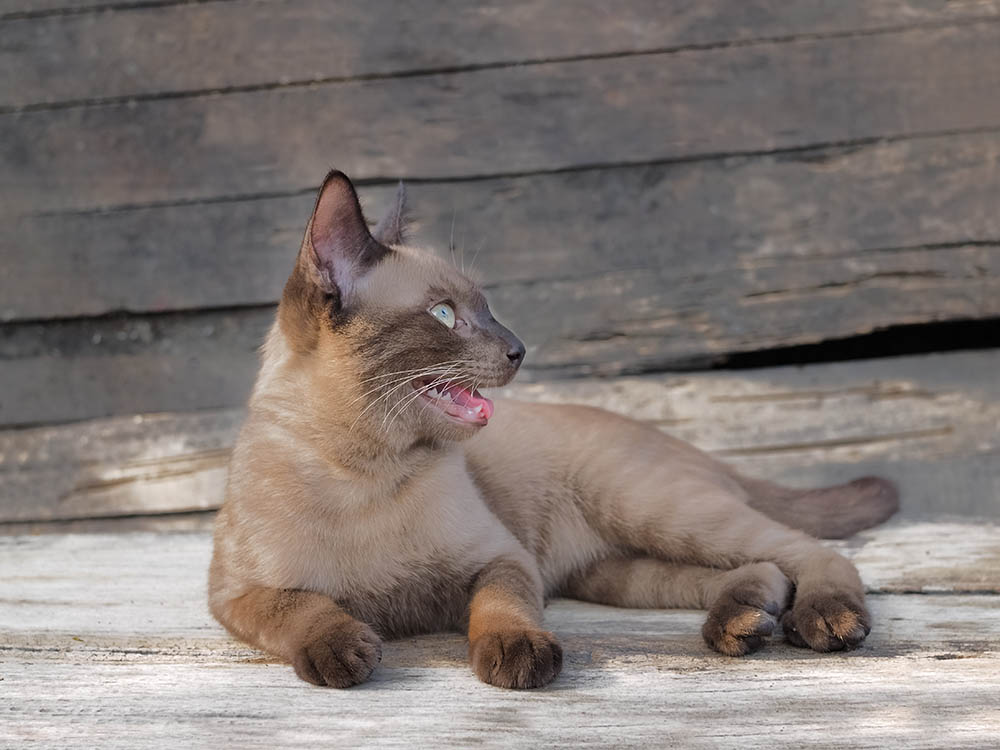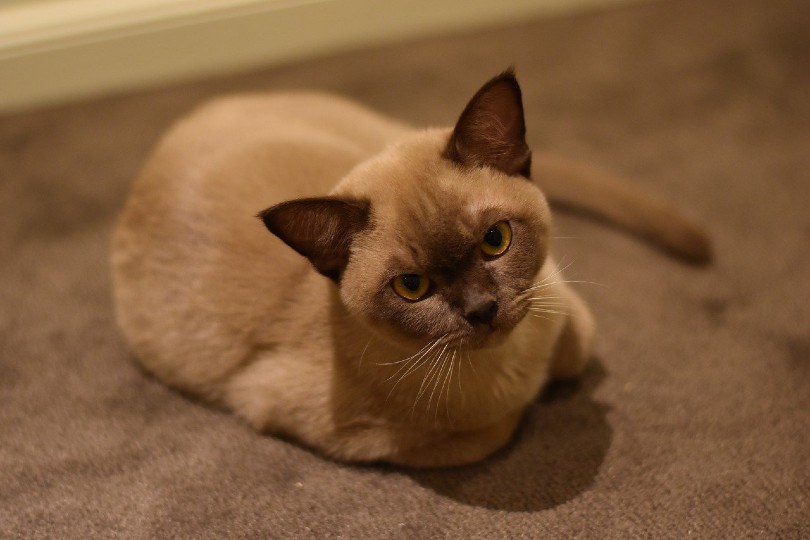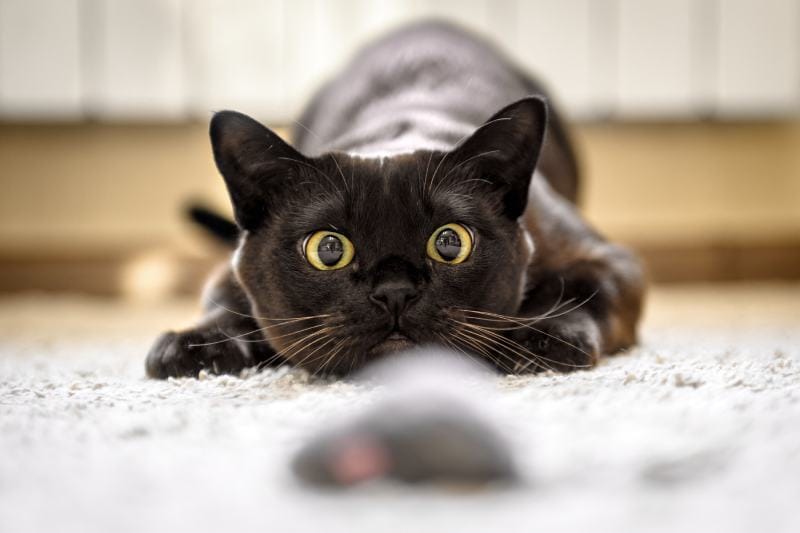
With plenty of benefits on either side, choosing between a cat and a dog for the family pet can be challenging for any household. A Burmese cat might be worth a look for those unwilling to compromise.
Burmese cats bring a puppy-like personality in a gorgeous feline package, giving animal lovers the best of both worlds. Full of life and affection, these cats carry an abundance of quirks and character that help set them apart from the average breed. Prospective pet parents have much to discover in this uniquely friendly feline. We’ll get you started with these 11 surprising Burmese cat facts.
The 11 Facts About Burmese Cats
1. Burmese Cats Have Large Litters
Spaying and neutering are crucial with any pet you bring into the house, especially adventure-seeking cats. With a Burmese, desexing can save you from the frustration of unwanted household behaviors and a surprisingly large litter of kittens.
There’s no question that Burmese cats are some of the most prolific breeders in the feline family. A 1987 study revealed that Burmese had the largest litters of five researched cat breeds, producing an average of five kittens1. In 2006, researchers again noted the Burmese as having an above-average litter size of 5.7 kittens2.
To further cement the point, a Burmese cat also holds the record for the largest litter size. In 1970, a Burmese/Siamese queen in the U.K. had an astonishing 19 kittens in one litter. It’s an incredible number for any cat. Considering more sizeable cats tend to have larger litters, the medium-sized Burmese’s breeding efficiency becomes all the more impressive.

2. There Are Numerous Accepted Burmese Coat Colors
An essential distinction of the original Burmese was the sable-colored coat. Dr. Joseph Thompson saw a breeding opportunity in his unique walnut-brown cat, Wong Mau, when he acquired her in 1930 and hoped to replicate her traits into a new line. When several Burmese appeared in the classic warm sable color, it quickly became the breeding focus.
While many of the newer varieties reproduced the rich brown tones in their offspring, variations persisted despite the breeders’ best efforts. Products of a dilute gene, these colors eventually found acceptance from the Cat Fanciers Association as true Burmese varieties. By CFA standards, Burmese colors include the original sable alongside champagne, platinum, and blue, which is a mid-gray hue with warm fawn undertones.
The U.K.’s leading cat registry, the Governing Council of the Cat Fancy, allows an even broader spectrum of Burmese coat colors.
Color diversity has changed and continues to change as the Burmese lineage grows. Recently, researchers recognized a mocha variation in Burmese cats from Thailand, proving there’s still plenty to learn about the breed’s potential3.
3. The Burmese Coat Color Is Temperature Dependent
Predicting a Burmese cat’s final coat color while it’s a kitten isn’t always easy because it typically changes over time. When they’re born, Burmese kittens are usually light and almost completely white. Once exposed to the ambient temperature outside the warmth and safety of the womb, an enzyme initiates melanin production, causing their bodies to darken over time.
Melanin synthesis occurs more rapidly in areas where the cat feels cold, making them darker than the rest of the body. And if you can imagine the pointed coloration of a Siamese, you can likely guess which body parts feel the coldest. Though other genetic factors play a role in the final hue, warmer environments allow a lighter coat while the feet, ears, tail, and face develop the fullest color.
Burmese have a similar coloration, though to a lesser degree. The same enzyme has a milder effect, and the coat usually grows in a richer brown shade.

4. Burmese Cats Are Four Times More Likely to Develop Type II Diabetes
Less than 1% of cats develop Type II diabetes, which is an insulin resistance that can lead to increased urination, weight loss, and various worsening symptoms requiring medical intervention. Obesity and age are common risk factors, and no cat is completely immune. But while lifestyle plays the most notable role, heredity leaves many cats susceptible regardless of their diet or activity levels.
Burmese cats are perhaps the clearest example of that point. Studies have shown that Burmese are four times more likely to develop Type II diabetes than other breeds4. Interestingly, European and Australian Burmese cats are at a much higher risk than American Burmese, primarily due to genetic traces to the populations’ founding cats.
Type II diabetes isn’t the only condition to watch for in a Burmese. Other notable heritable health issues include orofacial pain syndrome, hyperlipidemia, and hypokalemia.
5. Burmese Cats Are Prone to Suckling
When you adopt a Burmese, you invite a healthy number of quirks into the home. Though rare, one unique trait you’re more likely to see in a sable-colored cat is suckling. Like their Siamese cousin, Burmese cats are prone to gently sucking on assorted soft items such as blankets and clothes, particularly wool articles.
Wool-sucking is a precursor to pica, which is a desire to eat non-food materials. Certain behavioral factors can cause it, including early weaning or low activity levels. The link between Siamese and Burmese cats suggests genetic causes as well.
Though a bit bizarre, wool-sucking isn’t usually an overly concerning behavior. Suckling, pica, and other offbeat or changing habits are still worth discussing with your vet to address potential risks and rule out related health causes.

6. Burmese Aren’t Shy Cats
One of the first pieces of advice many owners offer about owning a Burmese is ensuring they don’t get outside. For several reasons, keeping any cat indoors is a wise idea, but the bold Burmese is particularly open to new people and places. Curiosity can lead to them getting lost or having an unfortunate encounter with unfriendly people, pets, or animals.
One study of the heritability of behavioral differences among breeds found that Burmese were the least shy towards strangers. Burmese cats often demand constant affection and attention and will go where they need to get it.
7. Burmese Cats Are Prone to Over-Grooming
While they may have high-maintenance personalities, Burmese almost always have low-maintenance grooming needs. They don’t lose much fur even during the shedding seasons, and their short silky coats only demand occasional light brushing. And alongside their meager requirements, the cats help as much as possible by being fastidious groomers, though often to an excessive extent.
Over-grooming is more common in Burmese and Oriental cats. Burmese cats are more sensitive to separation anxiety due to their persistent desire to be around humans. Like suckling, over-grooming can be compulsive and a ritual to cope with stress. Although the cats are often inconspicuous with the habit, you’ll likely see signs in their patchy hair loss and increases in hairballs.

8. Burmese Live Longer Than Most Cats
You’re in it for the long haul when you bring a Burmese into the house. While their muscular bodies imply a healthy disposition, their long lives prove it. The average cat lives roughly 15 years, and we could consider them relatively long-lived by 18 years old. By contrast, a Burmese living for at least 20 years isn’t uncommon, with some even lasting well beyond age 25.
9. We Can Thank the Burmese for the Bombay
The Bombay, the blackest of the black cats, is easy to identify and a joy to have around. Bred in the late 1950s, these mini panthers owe their striking onyx coat to their Shorthair parents. Otherwise, Bombays borrow almost everything else from their sable Burmese side.
The result is a gorgeous extrovert with defining gold eyes made all the more vivid against the deep midnight-black hair. And the Bombay isn’t the only breed to come from Burmese cats. Other notable cats inheriting the playful personality and muscular build include the Burmilla and Tiffanie.

10. Burmese Are a Vocal Breed
If you’ve had experience with Siamese cats, it’s probably no surprise that their Burmese descendant is a bit of a loudmouth. Burmese cats can vocalize with the best of them and rarely show shyness or shame in voicing their demands to anyone within earshot.
What may be unexpected is how pleasant you’ll find their calls, especially compared to the Siamese. Burmese tend to have softer, raspier, and more soothing vocalizations, but they’ll still extend their conversations as long as possible.
11. Burmese Are Unexpectedly Heavy
Being big-boned may be a weak argument for anyone else, but Burmese cats have a legitimate excuse for their deceiving weight. Often called a “brick wrapped in silk,” the Burmese has a dense bone structure and muscular build to haul it around.
Despite their surprising weight, Burmese cats are a highly active, athletic, and energetic breed. As a Burmese parent, you may even appreciate the comforting security of the lapcat’s added bulk while cuddling.

Conclusion
One of the many joys of owning a Burmese is their natural talent for impressing and uplifting us daily. It takes a true pet lover to supply the attention they demand. But Burmese cats reward you handsomely with their charming temperament and affectionate nature. The breed is intelligent, playful, low-maintenance, and, as we’ve seen, full of surprises.
Related Read:
Featured Image Credit: Viacheslav Lopatin, Shutterstock







